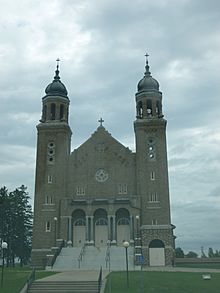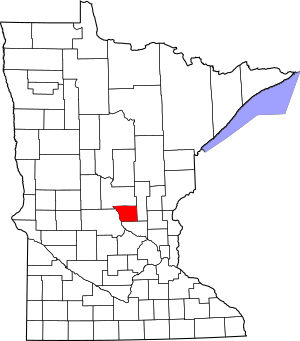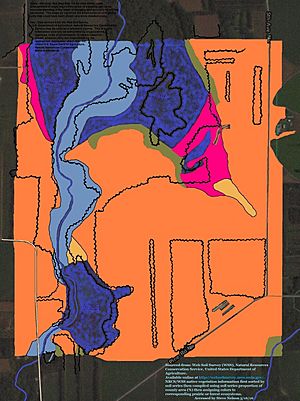Benton County, Minnesota facts for kids
Quick facts for kids
Benton County
|
||
|---|---|---|

Church of Saints Peter and Paul in Gilman, Minnesota.
|
||
|
||

Location within the U.S. state of Minnesota
|
||
 Minnesota's location within the U.S. |
||
| Country | ||
| State | ||
| Founded | October 27, 1849 (created) 1850 (organized) |
|
| Named for | Thomas Hart Benton | |
| Seat | Foley | |
| Largest city | Sauk Rapids | |
| Area | ||
| • Total | 413 sq mi (1,070 km2) | |
| • Land | 408 sq mi (1,060 km2) | |
| • Water | 4.8 sq mi (12 km2) 1.2%% | |
| Population
(2020)
|
||
| • Total | 41,379 | |
| • Estimate
(2023)
|
41,600 |
|
| • Density | 97.9/sq mi (37.8/km2) | |
| Time zone | UTC−6 (Central) | |
| • Summer (DST) | UTC−5 (CDT) | |
| Congressional district | 6th | |
Benton County is a county in the East Central part of the U.S. state of Minnesota. As of the 2020 census, the population was 41,379. Its county seat is Foley.
Benton County is part of the St. Cloud Metropolitan Statistical Area, which is also included in the Minneapolis-St. Paul Combined Statistical Area.
Contents
History
Established in 1849 and organized in 1850, the county is one of the oldest in Minnesota. It was named for Thomas Hart Benton, a United States Senator from Missouri. Its county seat for many years was Sauk Rapids, at the confluence of the Sauk and Mississippi Rivers. The county seat moved to Watab in 1856 and returned to Sauk Rapids in 1859. Sauk Rapids became the terminus of a railroad line in 1874, but was destroyed by a tornado in 1886. In 1897 the county seat moved to Foley, where it remains. As St. Cloud expanded into a metropolitan area, the southern part of Benton County became a suburb.
Geography
The Mississippi River flows southeast along Benton County's western border, and the Platte River flows south through the county's northwest corner, discharging into the Mississippi at the county's western border. The terrain consists of low rolling hills, wooded or devoted to agriculture. It generally slopes to the south and east, although its western portion slopes into the river valleys. The county's highest point is a small hill near the midpoint of the northern border, 1 mi (1.6 km) north of Brennyville, at 1,311 ft (400 m) ASL. The county has a total area of 413 square miles (1,070 km2), of which 408 square miles (1,060 km2) is land and 4.8 square miles (12 km2) (1.2%) is water. It is the fifth-smallest county in Minnesota by land area and fourth-smallest by total area.
Major highways
Adjacent counties
- Mille Lacs - east
- Sherburne - south
- Stearns - west
- Morrison - north
Lakes
- Donovan Lake (part)
- Graham Lake
- Little Rock Lake
- Mayhew Lake
Protected areas
- Benlacs State Wildlife Management Area (part)
- Bibles State Wildlife Management Area
- Englund Ecotone Scientific and Natural Area
- Sartell State Wildlife Management Area
- Wisneski State Wildlife Management Area
Climate and weather
| Weather chart for Foley, Minnesota | |||||||||||||||||||||||||||||||||||||||||||||||
|---|---|---|---|---|---|---|---|---|---|---|---|---|---|---|---|---|---|---|---|---|---|---|---|---|---|---|---|---|---|---|---|---|---|---|---|---|---|---|---|---|---|---|---|---|---|---|---|
| J | F | M | A | M | J | J | A | S | O | N | D | ||||||||||||||||||||||||||||||||||||
|
0.7
21
2
|
0.6
27
7
|
1.6
39
20
|
2.6
56
33
|
3
69
44
|
4.2
78
54
|
3.3
82
59
|
3.8
80
56
|
3.5
70
47
|
2.5
57
35
|
1.4
39
22
|
0.8
25
7
|
||||||||||||||||||||||||||||||||||||
| temperatures in °F precipitation totals in inches source: The Weather Channel |
|||||||||||||||||||||||||||||||||||||||||||||||
|
Metric conversion
|
|||||||||||||||||||||||||||||||||||||||||||||||
In recent years, average temperatures in the county seat of Foley have ranged from a low of 2 °F (−17 °C) in January to a high of 82 °F (28 °C) in July, although a record low of −43 °F (−42 °C) was recorded in January 1977 and a record high of 107 °F (42 °C) was recorded in July 1936. Average monthly precipitation ranged from 0.62 inches (16 mm) in February to 4.17 inches (106 mm) in June.
Demographics
| Historical population | |||
|---|---|---|---|
| Census | Pop. | %± | |
| 1850 | 418 | — | |
| 1860 | 627 | 50.0% | |
| 1870 | 1,558 | 148.5% | |
| 1880 | 3,012 | 93.3% | |
| 1890 | 6,284 | 108.6% | |
| 1900 | 9,912 | 57.7% | |
| 1910 | 11,615 | 17.2% | |
| 1920 | 14,073 | 21.2% | |
| 1930 | 15,056 | 7.0% | |
| 1940 | 16,106 | 7.0% | |
| 1950 | 15,911 | −1.2% | |
| 1960 | 17,287 | 8.6% | |
| 1970 | 20,841 | 20.6% | |
| 1980 | 25,187 | 20.9% | |
| 1990 | 30,185 | 19.8% | |
| 2000 | 34,226 | 13.4% | |
| 2010 | 38,451 | 12.3% | |
| 2020 | 41,379 | 7.6% | |
| 2023 (est.) | 41,600 | 8.2% | |
| U.S. Decennial Census 1790-1960 1900-1990 1990-2000 2010-2020 |
|||
2020 census
| Race | Num. | Perc. |
|---|---|---|
| White (NH) | 35,821 | 86.6% |
| Black or African American (NH) | 1,991 | 4.81% |
| Native American (NH) | 184 | 0.44% |
| Asian (NH) | 463 | 1.12% |
| Pacific Islander (NH) | 8 | 0.02% |
| Other/Mixed (NH) | 1,696 | 4.1% |
| Hispanic or Latino | 1,216 | 2.94% |
Communities
Cities
Townships
- Alberta
- Gilmanton
- Glendorado
- Graham
- Granite Ledge
- Langola
- Mayhew Lake
- Maywood
- Minden
- Saint George
- Sauk Rapids
- Watab
Census-designated place
Unincorporated communities
- Brennyville
- Duelm
- Fruitville
- Glendorado
- Granite Ledge
- Jakeville
- Mayhew
- North Benton
- Oak Park
- Parent
- Popple Creek
- Rum River
- Silver Corners
- Watab
Ghost towns
- Estes Brook
- Minden
See also
 In Spanish: Condado de Benton (Minnesota) para niños
In Spanish: Condado de Benton (Minnesota) para niños



